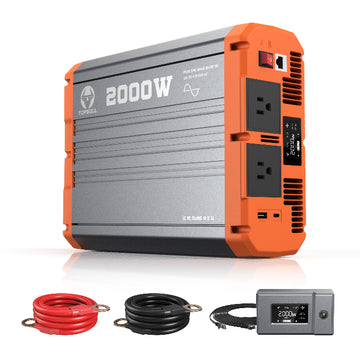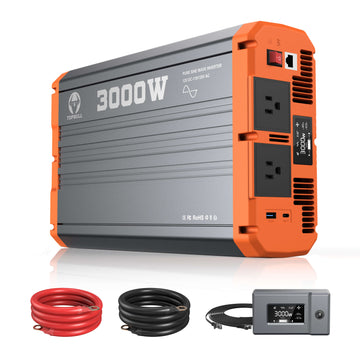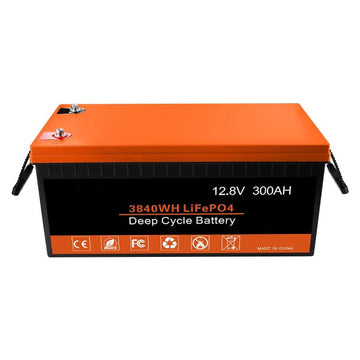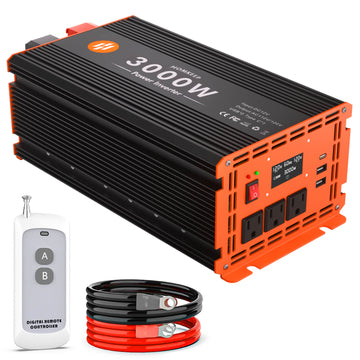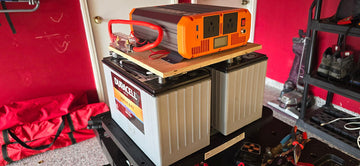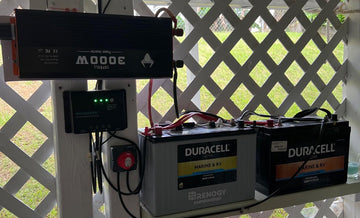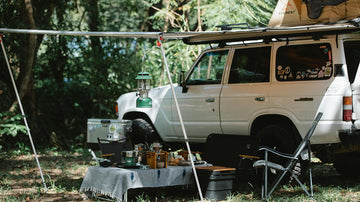For devices that require the use of 12-volt batteries, such as RVs, boats, and off-grid power systems , it is especially important to understand how to charge batteries via solar panels. This article will look at choosing the right size solar panel to ensure effective charging.
Table of contents:
- 12V Deep Cycle Battery
- Understanding the basic parameters of a 12V battery
- How to charge batteries with solar panels?
- Factors to Consider When Choosing Solar Panel Size for Battery Charging
- How many solar panels are needed to charge a 12V electric charger
- How many solar panels are needed to charge a 12V 200Ah lithium battery
- How long does it take to charge a 12V battery
- FAQs
12V Deep Cycle Battery
First of all, let's learn about 12V deep cycle batteries . 12V deep cycle batteries are batteries designed to be frequently deep discharged and recharged, with high cycle life and deep discharge capacity, and their structure is optimized to withstand high loads of power supply without being easily damaged. These batteries are widely used in applications where long term power supply or backup power is required, such as home backup power, caravans and recreational vehicles, and solar energy systems, to ensure the stability and reliability of power supply.
When selecting a battery, factors such as capacity, cycle life and cost should be considered; overcharging and over-discharging should be avoided when in use, and regular inspection and maintenance should be carried out to prolong the service life and performance of the battery.
Understanding the basic parameters of a 12V battery
It is very important to understand the basic parameters of a 12V battery before choosing a solar panel. Below are some of the key parameters explained in detail:
1. Voltage
- Nominal Voltage: Most deep cycle batteries have a nominal voltage of 12 volts. This voltage is usually achieved by combining six 2-volt lead-acid cells (in series), or a combination of lithium cells.
- Actual Voltage: The actual voltage of the battery may vary during the charging and discharging states. It may be between 12.6V and 13.2V when fully charged and around 12.0V when discharged to 50%.
2. Capacity
- Ampere-hour (Ah): The capacity of a battery is usually expressed in ampere-hours (Ah), which indicates the duration of the current that the battery can deliver at a specific discharge rate. For example, a 100Ah battery will provide power for 100 hours under a 1A load; under a 10A load, the battery will be depleted in approximately 10 hours.
- Kilowatt-hour (kWh): The energy capacity of a battery can also be expressed in kilowatt-hours; 1kWh is equal to 1,000 watts of electricity lasting 1 hour.
3. Depth of Discharge (DoD)
- Depth of Discharge: This refers to the percentage of the battery that can be safely discharged. For deep cycle batteries, a maximum depth of discharge of 50% to 80% is usually recommended. For example, a 100Ah battery with a set depth of discharge of 50% can safely use 50Ah of power.
4. Charging efficiency
- Indicates the ratio of input energy to output energy when charging a battery. The charging efficiency of deep cycle batteries usually ranges from 70% to 90%. The higher the efficiency, the shorter the time required for charging.
5. Cycle Life
- The number of times a battery can be charged and discharged under specific discharge and charge conditions. Cycle life is affected by factors such as depth of discharge, charging efficiency and usage environment. The cycle life of lithium batteries is usually longer than that of lead-acid batteries.
6. Self-discharge rate
- The proportion of batteries that lose a certain amount of charge on their own each month when they are not in use. The self-discharge rate of deep-cycle lead-acid batteries is usually between 3% and 5%, while lithium batteries have a lower rate of about 1%.
7. Size and Weight
- Size: The physical size of the battery determines its suitability for a particular application.
- Weight: Weight is also quite important for portable devices and transportation, especially in mobile applications such as RVs and boats.
Understanding these basic parameters can help you better select and use 12V batteries for specific power needs. Choosing the right battery type and parameters for different applications such as domestic, commercial or mobile equipment can improve the efficiency and long-term reliability of your equipment.
How to charge batteries with solar panels?
Charging batteries with solar panels is an environmentally friendly and economical option that can effectively utilize renewable energy. First of all, you need to choose a suitable solar panel according to the capacity of your battery and your daily electricity demand, generally speaking, the common specifications are 100W, 200W and so on. When installing, place the solar panel in a sunny place, make sure there is no shadow blocking, and you can adjust the angle of the panel to optimize the reception of sunlight. Ensuring power connectivity and stability is critical to the performance of the system.
After that, connect the solar panels to the solar charge controller and then connect the controller to the batteries. The main function of the charge controller is to regulate the charging process and prevent overcharging and overdischarging of the battery, thus prolonging the life of the battery. Special attention needs to be paid to polarity when connecting to avoid damaging the device. Charge controllers are usually equipped with indicator lights or LCD displays to facilitate real-time monitoring of the battery's charging status and power level.
In addition, it is important to regularly check the overall status of the system. You should clean the solar panels regularly to ensure their efficiency, and check the integrity of the batteries and connecting wires to avoid power loss or safety hazards due to poor contact. In sunny conditions, using solar panels to charge batteries not only provides reliable power support for home devices, RVs, boats, etc., but also significantly reduces electricity bills and enables a sustainable lifestyle.
Factors to Consider When Choosing Solar Panel Size for Battery Charging
When choosing a solar panel size for battery charging, a number of factors need to be taken into consideration to ensure a sound and efficient choice. The following are some of the major considerations:
1. Load Demand
It is critical to understand the power and operating hours of the equipment you need to power. Calculate the total daily power consumption (in watt-hours) of the equipment or system so that you can estimate the amount of solar panel power required in a given situation.
2. Battery capacity
Consider the capacity of the target battery (in Amp Hours Ah), as well as its charging and discharging rates. Determine the charging requirements of the battery to ensure that the solar panel selected will be able to provide sufficient power for an appropriate period of time.
3. Location and Sunlight Conditions
The climate and sunlight conditions in your area directly affect the efficiency and power output of your solar panels. Knowing the number of hours of sunlight in your area will help you determine if the size of panel you choose will meet your daily power needs under certain conditions.
4. Charge controller type
Choose your solar panel size based on the type of charge controller (PWM or MPPT) you have selected; MPPT controllers usually increase the efficiency of the system, so you may be able to choose a slightly smaller solar panel under the same conditions.
5. System losses
When choosing panels, you should also consider the energy losses in the system, including cable losses, inverter efficiency (if using DC-AC conversion), etc. Therefore, you may need to consider additional power to compensate for these losses to ensure charging efficiency.
How many solar panels are needed to charge a 12V electric charger
The size of the solar panel needed to charge a 12V LiPo battery depends largely on the capacity of the LiPo battery and the expected charging rate. Typically, the more powerful the solar panel, the more it can charge the lithium battery in the same amount of time.
According to common recommendations, 1W of solar panel can be equipped for every 1AH of Li-ion battery capacity. However, this ratio is for reference only, and the actual required solar panel power will also be constrained by factors such as light intensity, the efficiency of the solar panel, the influence of the charge controller, and whether or not it is necessary to fully charge the Li-ion battery for a length of time (e.g., full in one day or longer).
Specific recommendations are as follows:
Small capacity lithium batteries:
- For lithium batteries of 12V 10AH or less, it is recommended to equip 10-20W solar panels. This can fully charge the lithium battery within a day under good lighting conditions.
Medium capacity lithium battery:
- For lithium batteries up to 12V 20AH, a 20-40W solar panel is recommended. Again, under good lighting conditions, this is enough to fully charge the lithium battery in one day.
Large capacity lithium batteries:
- For larger capacity lithium batteries, such as 12V 4400AH, the power of the solar panel needs to be increased accordingly. According to the estimation of 1W for every 1AH, about 4400W of solar panel is needed. However, this high power configuration may not be common in practical applications and requires consideration of various factors such as cost, installation space, and charging efficiency. In practice, multiple solar panels may be connected in parallel to achieve the required power.
How many solar panels are needed to charge a 12V 200Ah lithium battery
The number of solar panels needed to charge a 12V 200Ah battery depends on a number of factors, including the power of the solar panels, light intensity, charging efficiency, and desired charging time. The following is a detailed analysis based on these factors:
1. Battery capacity and charging requirements
The total capacity of a 200Ah battery is 12V * 200Ah = 2400Wh (watt-hours).
To fully charge this battery, the solar panel needs to provide at least 2400Wh of power over a certain period of time.
2. Charging time and PV panel capacity
Assuming that the desired charging time is 5-8 hours, then based on the power vs. time relationship, we can calculate the minimum power required from the solar panel. For example, a full charge in 5 hours would require 2400Wh / 5h = 480W. Considering 60% efficiency, the solar panel would need to be rated at 480W / 0.6 = 800W.
3. Number of solar panels
According to the common solar panel specifications on the market, such as 260W, 300W, etc., we can calculate the number of PV panels required. In the case of a 300W PV panel, for example, 2 panels are required (800W / 300W ≈ 2.67, rounded upwards to 3, but 2 with slight redundancy is usually chosen given practical availability and cost).
Thus, charging a 200Ah battery requires approximately 2 solar panels of 300W or similar power (taking into account efficiency and redundancy). However, this is only a rough estimate, and the choice needs to be made based on local lighting conditions, desired charging time, and cost budget. If conditions permit, it is recommended to choose a slightly higher power solar panel to ensure charging speed and stability.
How long does it take to charge a 12V battery
The time it takes to charge a 12V battery depends on a number of factors, including the capacity of the battery, the power of the charger, the charging current, and the initial charge of the battery. Generally, charging a 12V battery takes between 8 and 13 hours, but specifics may vary.
Influencing Factors
- Battery capacity: The larger the battery capacity, the longer it takes to charge. For example, a 12V 60Ah battery commonly used in domestic cars may take close to 10 hours to charge under standard charging conditions.
- Charging current: The size of the charging current directly affects the charging speed. Theoretically, the ideal charging current of a battery should be 10% of its capacity, but it takes longer to charge in this way. In practice, people may choose a slightly higher charging current to shorten the charging time, but too high a charging current may cause damage to the battery.
- Charger power: The higher the power of the charger, the higher the charging current it can provide, thus shortening the charging time. However, you need to pay attention to the temperature of the battery and the stability of the charging process when using a high power charger.
- Initial battery charge: The higher the initial battery charge, the shorter the time required for charging. Therefore, it is recommended to charge the battery in time when the battery level is low to avoid over-discharge of the battery affecting its service life.
Lithium battery charging speed vs. other types of battery charging speeds
| Battery Type | Charging Rate | Charging Time |
| Lithium Battery | 0.5C - 2C | 1 - 3 hours |
| Lead Acid Battery | 0.1C - 0.3C | 6 - 12 hours or longer |
| NiCd | 0.5C | 1 - 3 hours |
| NiMH | 0.5C - 1C | 2 - 5 hours |
Description:
Charge rate (C value): the C value is the multiplier of the battery capacity, 0.5C means the charge current is half of the battery capacity, while 1C corresponds to the battery capacity.
Charging Time: is the time required to fully charge the battery under suitable conditions, the exact time may be affected by a number of factors, including the type of charger and the current state of the battery.
FAQs
1. What type of charge controller is needed to charge lithium batteries?
For lithium batteries, it is recommended to use a dedicated MPPT (Maximum Power Point Tracking) charge controller to improve charging efficiency and ensure safe charging.
2. Can solar panels be charged in cloudy or overcast weather?
Yes, solar panels can generate electricity even in cloudy or overcast weather, but the charging efficiency will be reduced.
3. How to ensure the safety of lithium battery during charging?
Using a proper charge controller can prevent overcharging, over-discharging and short-circuiting, thus ensuring the safety of lithium batteries. In addition, many lithium batteries have a built-in BMS (Battery Management System) to monitor the battery status.
4. Can I continue to connect the solar panel after the lithium battery is fully charged?
Once the LiPo battery is fully charged, it is recommended to disconnect the solar panel to prevent overcharging unless a charge controller with overcharging protection is used.
5.How do I charge the lithium battery when there is not enough sunlight?
If the effective daily sunlight hours are insufficient, consider using other charging methods (e.g. AC power) or increasing the number of solar panels.
6. How often do lithium batteries need to be recharged?This depends on the usage and capacity of the battery. If they are used frequently, they may need to be charged every day; if they are used less frequently, charging them according to the discharge of the battery is sufficient.
7. Can I use multiple solar panels in parallel?
Yes, multiple solar panels of the same specifications can be used in parallel to increase the total output current, but make sure to use panels of the same type and specifications to maintain balance.
8. What do I need to pay attention to when using solar panel energy charging in winter?
In winter, the efficiency of solar panels may be reduced. When using them, you should make sure that the batteries are not over-discharged and consider charging them on days with good sunlight.

